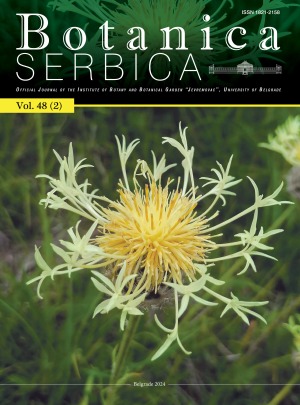
Volume 48 Issue 2 2024 |
Dedication in memory of Nedeljko Košanin (editorial)
|
Exploration of secondary metabolites from green algae as antimicrobial agents: A comprehensive review
|
KEY WORDS: Chlorophyta, bioactive compounds, antibacterial, antifungal, antiviral, drug resistance. |
Determination of the chemical composition, DNA cleavage, binding and antioxidant activities of Vincetoxicum scandens
|
KEY WORDS: Antioxidant activity, DNA cleavage, HPLC-DAD, Vincetoxicum scandens |
Leaf shape and size variability of Dryas octopetala in the Central Great Caucasus (the Kazbegi region, Georgia) based on traditional and geometric morphometrics
|
KEY WORDS: alpine ecosystems, Caucasus, landmarks, soil pH, leaf morphological plasticity |
Exploring the potential of bilberry extracts as natural antifungal and bioherbicidal agents in agriculture: composition and antioxidant activity
|
KEY WORDS: Antioxidant, antifungal, Vaccinium myrtillus, essential oil, bioherbicidal activity |
Clinopodium menthifolium subsp. menthifolium in the Central Balkan Peninsula - essential oil composition in relation to climatic conditions
|
KEY WORDS: Calamintha sylvatica, volatile compounds, bioclimatic parameters, Central Balkans, piperitone epoxide, limonene |
The protective role of exogenous proline in pepper callus exposed to long–term cold stress
|
KEY WORDS: Capsicum annum, free radical, lipid peroxidation, oxidative stress, tissue culture, tolerance |
Bio-based solution for improving plant growth under unfavourable conditions: Bacterial inoculants for bird’s foot trefoil and orchardgrass grown in acid soil
|
KEY WORDS: acid soil, Bacillus megaterium, Mesorhizobium sp., Dactylis glomerata, Lotus corniculatus, nutrient composition |
Red-list of moss species of Serbia: 2024 assessment
|
KEY WORDS: threat assessment, conservation, bryophyte, extinction risk |
Propagation of Campanula bayerniana (Campanulaceae) by seeds as a reproduction model for the conservation of threatened small-seed plant species
|
KEY WORDS: Campanula bayerniana, ex situ conservation, seed reproduction, small-seeded plant species |
Chemophenetic investigation of epicuticular n-alkanes in Juniperus L. section Juniperus L. from the Balkans
|
KEY WORDS: cuticle, n-alkanes, junipers, chemotaxonomy, Juniperus communis, Juniperus deltoides, Juniperus macrocarpa |
TauL1, TauL2 and TauL3 gene-pools of Aegilops tauschii essentially differ in their genetic expression patterns
|
KEY WORDS: adaptation, goat-grass, differentially expressed genes, intraspecies divergence, transcriptomes |
An ethnobotanical study on the usage of wild plants from Tara Mountain (Western Serbia)
|
KEY WORDS: Balkans, wild plants utilisation, folk medicine, human and animal nutrition, Vaccinium myrtillus |
Centaurea ozrenii (Asteraceae) ‒ a new local endemic and extremely rare species from Mt. Ozren near Sjenica in Serbia
|
KEY WORDS: Balkan flora, sect. Acrocentron, new species, taxonomy, chromosome number |
A nomenclatural and taxonomic re-evaluation of neglected Centaurea candelabrum Hayek & Košanin (sect. Acrocentron, Asteraceae) and related serpentine endemics from the Balkan Peninsula
|
KEY WORDS: Centaurea melanocephala complex, lectotype, overlooked taxa, typification |
New records and noteworthy data of plants, algae and fungi in SE Europe and adjacent regions, 18
|
KEY WORDS: new report, Acrocordia gemmata, Astragalus angustifolius subsp. balcanicus, Broussonetia papyrifera, Datura innoxia, Diatoma elongata, Gymnadenia frivaldii, Hemerocallis lilioasphodelus, Hyphonectria buxi, Montia arvensis, Orchis × angusticruris, Peniophora tamaricicola, Pistia stratiotes, Pseudanabaena thermalis, Rhizomnium magnifolium, Sphagnum medium, Weissia squarrosa, SE Europe. |
New records and noteworthy data of plants, algae and fungi in SE Europe and adjacent regions, 19
|
KEY WORDS: new report, Buxbaumia viridis, Epipactis purpurata, Euphorbia orjeni, Fallopia × bohemica, Leptodon smithii, Mannia triandra, Nitellopsis obtusa, Nitzschia reskoi, Nuphar lutea, Ophiognomonia melanostyla, Orchis × beyrichii, Plagiostoma apiculatum, Podosphaera polemonii, Russula sapinea, Saxifraga pedemontana subsp. cymosa, SE Europe |
Physiological characterisation of aquatic traps in the epiphytic carnivorous plant Utricularia humboldtii
|
KEY WORDS: trap firing, water pumping rate, trap thickness, aerobic respiration rate |


